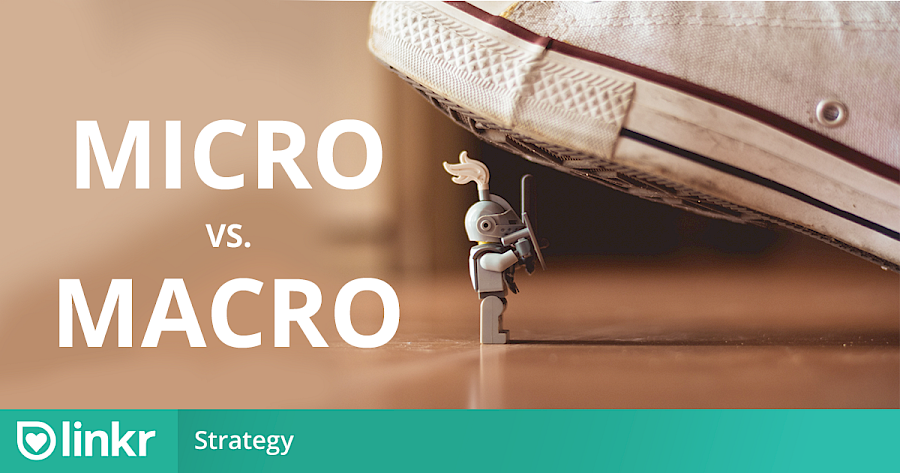Identifying the right influencers for your campaign is not so easy. There are a number of factors that come into play that may affect your decision. The debate between macro-influencers and micro-influencers never ends. But who exactly should you work with?
Most companies look at the numbers when they’re looking for content creators, and the first and possibly the most important number they look at is the follower count. It’s a simple, straightforward figure that determines what happens to your campaigns, but not in the way you think.
The number of followers you have affects your reach and engagement, but having more followers does not necessarily mean having more reach and higher engagement rate. Sometimes, the behavior of social media users can be difficult to predict. That’s why you hear brands collaborating with big celebrities to no avail.
Let’s discuss the important factors to consider when choosing influencers, and let’s see how macro- and micro-influencers stack up against each other?
REACH
This one is easy. When it comes to reach, the bigger names win. The more followers you have, the more people see your post. It’s as simple as that. Hence, if you’re looking for influencers who can make your brand known to more audiences, you probably should look for big YouTube and Instagram stars.
A macro-influencer will in most cases have a farther reach than a micro-influencer. It’s not surprising for a popular YouTuber with more than a million followers to have a million views on his sponsored video.
At face value, it would seem to take about 20 micro-influencers on the same platform to reach the same number of people. But reach isn’t everything.
ENGAGEMENT RATE
Just because a million people saw that Instagram post, it doesn’t mean that all of them interacted with the post. Engagement means likes, shares, and comments. It’s a more important number than reach is. A photo can have a wide reach, but it doesn’t engage audiences to do anything else other than view it and scroll down. Engagement tells us whether your post resonates well with your audience, but that’s just half of the story.
Engagement isn’t exactly the same as engagement rate. Overall, someone with more followers is expected to have more engagement on his or her posts than someone with fewer followers. However, when you compute the engagement rate, as in the ratio between the engagement and the number of followers, you will see that influencers with between 1,000 and 10,000 followers have the highest engagement rates despite having significantly smaller reach.
https://www.instagram.com/p/CBK63N9J84a/
In fact, engagement rate tapers off as you go up the follower count ladder.
There are a number of reasons why engagement rate drops as you go up the tiers of influencers:
More followers mean more fake and inactive accounts. These accounts don’t engage with your posts.
Macro-influencers are less intimate with their followers, who crave authentic connections.
Micro-influencers are more able to interact with their followers. On social media, interaction makes for a loyal audience.
Large social networks centered around a popular influencer are too incredibly diverse to create a community that cares about every post of the influencer.
Micro-influencers are niche-focused. You tend to pull in a homogeneous community when you’re posts are within a field.
Micro-influencers tend to be authorities in their niches who post helpful content, as opposed to celebrities and mega-influencers who post basically about themselves.
Did we just say that micro-influencers are clear winners when it comes to engagement rate?
COST
Ask any company who has asked celebrities or big influencers to endorse or feature their products, and they will tell you they spent huge amounts of money for these big names. A top YouTuber with 3 million followers can charge more than $150,000 for a video. Mega-influencers on Instagram can charge around $75,000 for a post. So, yes, the reach and brand awareness these influencers offer come with a hefty amount.
For start-ups, even $75,000 is a huge amount of money to risk. Even business people who have been around for years would hesitate spending that huge amount of money for a single post, especially when there are much less expensive alternatives.
You can ask an influencer with over 100,000 subscribers for a sponsored YouTube video for a charge of $3,000 or perhaps an Instagram feature for $1,000. Micro-influencers charge much less. Most micro-influencers on Instagram charge less than $250 per sponsored post.
Now, think about this. Say, an Instagram content creator with 200,000 followers asks $2,000 for one sponsored post. For the same amount, you can work with 6 content creators, each having 50,000 followers. With the latter choice, your campaign can reach more people.
With the right strategy, collaborating with Instagram influencers whose follower counts are between 1,000 and 100,000 becomes a much more cost-effective choice.
Now, imagine working with micro-influencers on a platform like linkr and getting bigger bang for the buck.
RELEVANCE
Here’s a simple thought experiment: if you’re looking for the best point-and-shoot camera, whose recommendation would you pay attention to, a celebrity’s or a camera review vlogger’s?
While most macro- and mega-influencers are celebrities, micro-influencers are niche experts and thought leaders who specialize in a specific field. As a result, they also have a niche audience, who tune in to similar content. They are able to generate better leads with higher conversion rate.
https://www.instagram.com/p/B_nRrK5IGV4/
The problem with macro-influencers is they don’t have a niche, at least most of them don’t. They’re basically entertainers who post anything to gain views, likes, and shares. Their posts can be anything from their daily routine to their visit to a dentist. How many YouTube stars have you seen doing make-up one day, recording a video of them walking their dog to the park next day, and then cooking pasta on another upload? Their posts vary depending on their whims or the requests of their audience. Their followers are like voyeurs to their private lives. That’s why when they start featuring brands, their audience will take their recommendation with a grain of salt.
A macro-influencer or a celebrity can make your brand known to a much bigger audience than a small influencer. But if they are not relevant to your brand, a good reach is basically all you will get. Your campaign becomes nothing more like a celebrity ad that people passively look at, if not completely ignore.
The issue of relevance takes us to the next factor that determines the value of a content creator.
AUTHENTICITY
If you want to know how to do influencer marketing on Instagram, one of the things you should be concerned about is authenticity. There’s a reason why only 3% of consumers will take a celebrity endorsement seriously. Celebrities lack authenticity. We know they’re being paid when they endorse a product or a service. We know quite well they won’t advocate a brand without being compensated. That mega-influencer, who is practically a celebrity, suffers from lack of authenticity, too.
People would rather consider buying a product mentioned by a regular person. They readily trust recommendations from micro-influencers for the following reasons:
Micro-influencers are niche experts.
Micro-influencers are more intimate with their audience. This intimate relationship establishes trust.
People view these relatively small content creators as people just like them.
Influencers with less than 100,000 followers have more influence on their followers.
Micro vs Macro Influencers: The Takeaway

Both macro- and micro-influencers have a place in marketing. If you’re after reach and brand awareness across the board, working with big YouTube stars or Instagram celebrities is your best bet. However, not everyone can afford social media personalities with more than 100,000 followers, let alone anyone with over a million followers. Fortunately, those with less than a hundred thousand followers have a good role in marketing. We’ve established how they win over their larger counterparts when it comes to real engagement, cost, relevance, and trust.
Should you skip macro-influencers? Not at all. Some macro-influencers may be relevant to your brand, and collaborating with them is not bad, especially if your budget permits. However, focus on working with micro-influencers when cost-effectiveness and conversion are what’s most important to you.
Working with multiple content creators entails more effort, more communication threads, and more tasks. Or maybe not. An influencer management platform like linkr takes care of the common problems brands encounter when working with several influencers.
Get started with your first campaign today.
Sign up for a risk-free trial!



